
HONDA Civic Sedan
Generations Timeline, Specs and Pictures
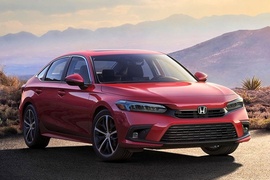
After selling more than 12 million Civics since the first generation in the U.S. alone, Honda’s compact contender evolved into a much sportier version for the eleventh generation.
Maybe the classic internal combustion engines were on their last stint. Still, Honda didn’t want to say hello to the electric age before offering a state-of-the-art turbocharged gasoline powerplant. Also, the carmaker knew that its customers were looking for sporty vehicles and excellent daily drivers.
The exterior showed a bold stance, with an up-market front fascia that resembled its bigger brother, the Accord (U.S. version). Its angular-shaped LED headlights were narrow and swept-back on the sides. A broad grille took the most significant part of the front bumper’s lower side, flanked by two side-scoops with LED fog lights. On the side, the beltline featured a step above the rear wheels, visually connecting the trunk area with the rest of the vehicle.
Inside, Honda returned to its roots and imagined an interior focused on the driver. Its pulled-back A-pillars, the low hood, and the flat dashboard gave a panoramic-view feeling, like in older Hondas. The Japanese carmaker was criticized for the Civic’s tenth generation seats and returned with a much better offer. They looked more like those installed in the eighth generation. In the instrument panel, Honda returned to its original concept. It placed the tachometer and the speedometer flanked by the coolant temperature and the fuel dial but in a modern 7” or 10.2” LCD. The floating-design 7” or 9” infotainment touchscreen placed on top of the center stack had about the same height as the instrument cluster, depending on the trim level.
Under the hood, Honda started with a 2.0-liter naturally aspirated engine as the base model, complemented by a 1.5-liter turbocharged and direct-injected unit.
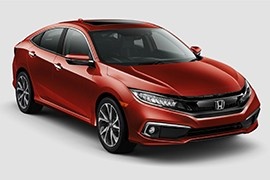
Even though it wasn’t too much since the tenth generation of the Honda Civic was launched, the Japanese car-maker introduced a facelift for it in 2018.
For the tenth generation, Honda used turbocharged and naturally aspirated engines, depending on the trim level. The design of the 2019 sedan, coupe, and hatchback was slightly revised along with a better-equipped interior. The 2019 Civic sedan was available in the U.S. in five trim levels, but that number decreased on the European models.
For the front side, the bumper was redesigned along with a new pair of headlights. For the Touring trim level, the LED headlights were upgraded to a new design to give the lights a wider and longer high-beam. In the back, there was a different bumper and a single, wide and flat, central exhaust.
Inside, the most important feature for the users was the volume knob, instead of a touch-slider that was annoying and difficult to use. The Civic also packed the safety system named Honda Sensing that helped the driver in keeping lanes and distances, plus the adaptive cruise control.
Under the hood, the 2019 model received a standard 2.0-liter naturally aspirated engine mated as standard with a 6-speed manual, or with a CVT that was an option. The 1.5-liter turbocharged unit was more powerful and for almost all the trim level it was mated as standard with a CVT and only on the base trim level transferred its torque via a 6-speed manual.
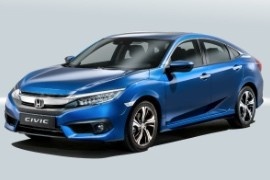
The 10th generation Honda Civic sedan looks sportier than ever in 2016.
Virtually everything about the 2016 Civic Sedan is new - an all-new vehicle architecture, sporty and sophisticated new interior and exterior styling, a more spacious and high-quality cabin, two advanced new engines, and a host of new premium features and technologies. Lower, longer, wider and more muscular than the previous generation, its flowing lines, new signature chromed “wing” front fascia and available premium LED lighting, extended wheelbase and short overhangs brand the new Civic as a leader in its class, both technologically and in design.
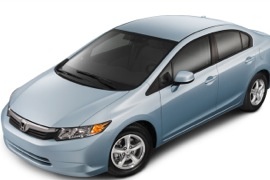
The Honda Civic is known for its rev-happy engines and for its performance in the hot hatch segment.
But also, let’s not forget about its eco-friendly models. From the first Honda Insight to the hybrid versions nowadays, the Japanese carmaker tried to built engines for everyone. The CNG version is one of those, available already in most of the united states. With this in mind, Honda Civic Civic Natural Gas continues as the only mass-produced natural gas sedan available in the U.S. at the time of its launch in 2013.
Under the hood, the engineers installed the 1.8-liter unit with 110 hp. Its power may not be exhilarating, but its fuel-efficiency is. With its EPA fuel economy rating of 27/38/31 mpg (city/hwy/combined) it is a very useful vehicle for someone who needs both range and a low cost fuel choice.
The 2013 Civic Sedan has a new front end and some new technical enhancements, which will make the car more planted on the road and more pleasant to drive. The rear suspension has been enhanced with a thicker stabilizer bar and new bushings. Thus, the firm suspension, for which the Civic is known, was softened and it is easier to live with it on a day-to-day commute.
Inside the cabin, the 2013 Honda Civic provides a host of new standard features, including Bluetooth HandsFreeLink, USB/iPod interface, SMS text message function. Available on Honda Civic Natural Gas, the Honda Satellite-Linked Navigation System provides routing and guidance to individual addresses.
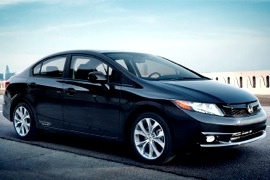
Honda introduced the ninth generation of the Civic sedan Si in the spring of 2011 and made it smaller and lighter than its predecessor while adding more torque under the hood.
The Japanese carmaker was ready to introduce the ninth generation of the Civic in 2009, but the project was frozen due to the world financial crisis. Honda didn’t want to risk a new model while the eighth generation was just five years old. It delayed the project for another two years and made it lighter and smaller on the outside.
It still sported the same sharp-nose design, with swept-back headlights and a mesh-grille between them where the Si red badge took a discreet spot on the car’s left side. The bumper featured an additional lower grille flanked by the fog lights. At the back, the carmaker added a lip-spoiler on the trunk’s lid edge. Honda didn’t want to make it too flashy, and the final result was looked just like a regular sedan with a small tail on the trunk and 17” alloys.
Inside, the Civic Si featured a few unique upgrades over the regular Civic Sedan. Its front bucket seats sported a red Si badge embroidered on their seatbacks. Their red stitching matched the thread used to make the gear knob. A Si badge adorned the bottom of the steering wheel as a reminder for the driver. Unlike its coupe sibling, the sedan offered four doors for easier ingress and egress and two comfortable seats on the rear bench with adult-size legroom and headroom.
Unlike its predecessor, the ninth generation Si came with a 2.4-liter i-VTEC engine. Thus, the torque increased from 139 lb-ft (188 Nm) to 170 lb-ft (230 Nm), while the power grew with seven ponies. Its helical-type limited-slip differential was part of the Si package.
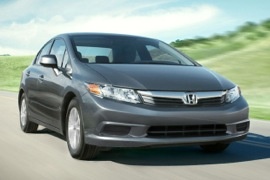
Honda introduced the ninth generation of the Civic, also in sedan shape, and it was that kind of vehicle that didn’t show the owner’s social status.
The Japanese carmaker raised the stakes with the Civic’s ninth generation, which was no longer just another box-on-wheels commuter car. It proved to be a successful recipe that offered more for less. The Civic reputation grew not on its high-performance SI models as much as on the car’s reliability, and the ninth generation added family-oriented features in the vehicle.
With its sharp-looking front fascia and swept-back angular headlights, the Civic Sedan looked more like a sports sedan than a regular compact-segment three-box vehicle. Its raked windshield, low greenhouse, and sloped rear windscreen resembled a coupe shape. The tall trunk lid looked rather bland in the back due to the big metallic area since the carmaker installed the taillights only on the quarter panels.
Inside, Honda installed a futuristic-looking dashboard with a split instrument panel. While the tachometer was in front of the steering wheel, the Civic showed the speedometer and other relevant info on a separate panel upper on the dashboard. Its center stack featured the infotainment unit above the climate control panel. Despite the sporty-looking exterior, the seats wore little bolstering. The bench provided good room for two adults in the back, with less legroom for the center passenger.
Under the hood, Honda installed its trustworthy 1.8-liter VTEC gasoline engine and paired it with a six-speed manual or a five-speed automatic.
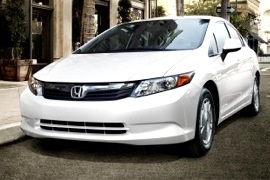
In 2012, Honda launched a more fuel-efficient vehicle for the American market.
It was called the Civic HF and was harking back to a special edition of the Honda CRX from the 90s, which was also called HF and was really frugal regarding fuel consumption.
On the outside, there were few things which differentiated the HF Civic compared to the other normal versions. It featured smaller, 15” alloy-wheels with low resistance tires. Additional underbody panels were fitted to decrease the model’s wind-resistance. The last touch to improve economy was a decklid spoiler that reduced the turbulences behind the car, improving aerodynamics.
At that time, Honda had few gasoline engines in its lineup, but chose to install the 1.8-liter unit, which was calibrated for fuel-efficiency. The 142 hp engine was mated to an automatic 5-speed gearbox. The final result was a decrease in the fuel consumption and the HF could do 41 mpg (5.7 l/100 km) instead of 37 mpg (6.3 l/100 km) as the other versions.
As any Honda, though, the vehicle was sporty enough to be sought after by younger customers. Its four-wheel independent suspension was a good reward for its sportier drivers. In 2012, when the worldwide economy had started to get back in shape, the demand for fleet vehicles grew and the HF version was fit for the job, until the Civic CNG showed up and took its sibling’s customers.
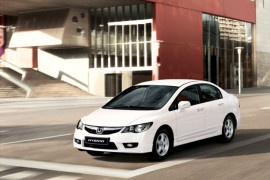
Honda introduced a facelifted version for the European Civic sedan in 2008, preparing it for the Euro 5 emission standards.
While the U.S. customers had to wait for a few more years to receive a new version of the sedan, the Europeans already had it refreshed. The Japanese carmaker already had its new factory in Turkey up and running and needed to fill it with orders.
The facelifted version featured similar headlights and grille but with a different bumper. Unlike its predecessor, which sported rectangular fog lights, the 2008 model received round ones. Its lower grille was trapezoidal. In the back, the carmaker installed new taillights with a turn signal on the lower-outer area.
Inside, the carmaker introduced new materials inside the cabin and a new infotainment unit. For the middle trim level, the cabin received sport-trimmed black cloth seats with suede bolsters. Honda installed a 60/40 split bench in the rear as standard, expanding the trunk size.
Under the hood, the carmaker offered the car with only one engine option for the European market: a 1.8-liter, single-camshaft i-VTEC unit carried over from its hatchback sibling. It paired it with a six-speed manual while a five-speed automatic was on the options list. The carmaker used the same 1.3-liter IMA (Integrated Motor Assist) unit paired to a CVT transmission as standard for the hybrid version.

The eighth generation of the Honda Civic sedan was sold all over the world.
But even if it had the same name with the Civic hatchback, it had very few things in common.
Usually, when a car-manufacturer builds a hatchback and wants to do a station-wagon and a sedan version, just chop the back or add some body panels. But Honda did it differently.
The sedan was built in Turkey with the gasoline engine, in Japan with the hybrid engine and it didn’t have a diesel version. Moreover, the look of the vehicle didn’t have anything in common with the hatchback. The bigger headlights and taillights were something special for the model.
Inside, specific seats, with the gasoline tank installed under the rear seats made room for a lower driving position. The instrument cluster was futuristic, with a split display system. On the upper part was the speedometer and on a lower part other non-essential for driving info such as the trip-meter or check-lights.
Under the hood, there was a 1.8-liter engine that was common with the hatchback and it was mated to the same 6-speed manual transmission. An option for an automatic transmission was available. The biggest difference for the engine compartment was the introduction of a hybrid unit that was mated to a CVT. That wasn’t available for the hatchback.
For the suspension, the 2006 Civic Sedan had an all-wheel independent suspension with a McPherson up front and a multi-link system in the rear, unlike the torsion beam for the Hatchback. As a bonus, in Japan, a Type R sedan was available, with a 2.0-liter naturally aspirated engine that, in some special editions, boasted up to 220 hp.

Honda introduced a facelifted version for its Civic Sedan in 2003 and offered it more safety systems than before.
On top of that, it provided it with a hybrid drivetrain.
While the Civic hatchback and coupe took most of the media attention, the sedan stole the buyers’ hearts that tried to get one. It was already a well-known vehicle for its simple yet functional design and, moreover, for its impressive reliability. It was a “just add gas” vehicle. But it was more than that.
It can’t be said that it was a work of art. It rather looked plain, if not dull, with its angular headlights and its single-slat grille at the front. The profile looked like the car would struggle to get to 60 mph (97 kph) harder than any other competitor. Yet, the car was the proof to not judge a book by its cover. Or a car by its shape, whatever works.
Inside, the simple style continued with a flat, low-mounted dashboard. Its center stack was straightforward with the controls for the AC-unit (if fitted) and the stereo. The instrument cluster showed nothing new than the rest of the Civic, with a four-dial layout. Honda installed very low seats for the compact-sedan segment, and the driver had its heels about the same height as the bottom.
But Honda was surprising on other sections. For instance, it featured independent suspension in all corners and a lively 1.7-liter engine under the hood paired to a 5-speed manual. A four-speed automatic was on the options list. The biggest surprise was the 1.3-liter Hybrid version that offered an excellent 39 mpg (6 l/100 km) in the city and 54.7 mpg on the highway (4.2 l/100 km).
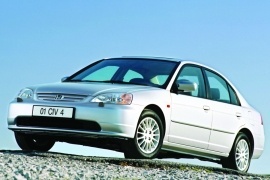
Honda unveiled the seventh generation of the Civic in 2000, and it was available in a few body shapes, and they didn’t share too many body panels between them even though they were built on the same platform.
Some people considered that it was a step back for the Japanese carmakers since it simplified the front suspension, which was considered too complicated for a simple, family sedan. The carmaker switched from multi-link to McPherson, which offered an efficient solution for a car of that size. Fortunately, it kept the rear independent suspension, which provided better comfort, especially for the rear seat passengers.
From the outside, the three-box version featured a more aerodynamic stance with streamlined headlights and corner-mounted turn-signals incorporated into the main lamps. Its height was lower than the hatchback versions and just a little bit higher than the coupe. In the back, the taillights were split between the rear quarter panels and the trunk lid, which was unique among its siblings.
Due to its wheelbase, it offered enough legroom for the rear seat passengers, bigger than in the hatchback versions. Unlike the hatchbacks, it featured a floor-mounted gear-stick and a center stack extended to the center console.
Under the hood, the sedan was offered exclusively with gasoline engines ranged between 90 hp and 131 hp, depending on the market. A hybrid version became available in 2002.

One of the best-known models from Honda entered the market in 1995 with increased dimensions over its predecessor.
After 23 years since the first Civic, the sixth generation was the last that belonged in the subcompact segment. It was available with four body versions, and the only version sold worldwide was the 4-door sedan. It featured advanced technical solutions for its times and remained one of the most appreciated generations in the Civic history.
Despite sharing a similar design trend as its predecessor, the 1995 Civic was longer and taller, but not wider. At the front, the headlights were covered with clear lenses. A center grille with a chromed badge in the middle and a chromed bar on top was characteristic for the sedan version. In the lower bumper, the Japanese designers installed a wider and taller air intake to cool the engine and the AC compressor. The rear taillights featured lower mounted reversing lights before the 1998 facelift, which were moved on the upper side after that.
The interior was still simple, with a black dashboard and cloth seats. Its classic instrument cluster, with white-on-black lettering, provided easy to read and understand gauges. A half center stack was installed in the middle and filled with the radio and the HVAC controls. Depending on the trim level, the car featured cranked or power-windows, plus a sunroof. Due to the unusually long wheelbase for its class, it offered decent legroom for the rear passengers.
Under the hood, Honda installed a wide range of gasoline engines ranged between 90 hp and 160 hp. All versions were paired to a 5-speed manual gearbox. For specific markets, a 4-speed automatic was available as an option.

Honda took a new path and left behind the fourth generation’s wedge-style and brought a new era with a biodesign-inspired shape for the 1991 model.
Unlike its predecessors, Honda insisted on offering the Civic with market-specific body shapes. The only version which was available in every market was the four-door sedan. Due to its increased wheelbase and its options, it looked like it aimed for higher market segments.
Honda designers decided that it was time for a change, and with the new, rounded edges and flowing body lines, they achieved a 0.32 drag-coefficient, similar to a Nissan 300ZX. The raked windshield and the sloped rear window contributed to that result. Since it was built on the same platform as the hatchback and the coupe, it featured a short decklid, creating a cab-forward design look.
The interior was plain, with gray trims on the dash and door panels. Honda insisted on having sporty handling, even if it was just a regular family vehicle. To do that, the engineers installed lower seats. It didn’t feature any folding seatback for the rear bench.
Unlike most of its competitors, the Civic sedan featured independent suspension in all corners for enhanced speed cornering and a comfortable ride. Under the hood, there was something for everyone. While the base version featured a 90 hp unit, the top version was powered by the well-known 1.6-liter VTEC engine that provided 160 hp.
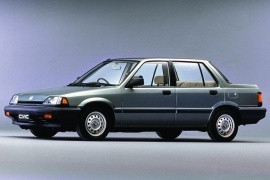
Honda considered that the compact-segment buyers deserved more attention and offered superior technologies in a market where the main criteria were the price.
There was no other carmaker to offer an all-wheel independent suspension in the segment. Moreover, it offered a complex system that was not available even for medium-sized vehicles. As a result, it won the comfort battle against all of its main competitors, and the customers started to rethink their budgets. Soon, the fourth generation of the Civic started to gain customers’ hearts.
At a glance, it looked just like its predecessor, but it was a completely different car. It kept the same narrow, rectangular horizontal headlights and a small grille on the lower part of the bumper. In the rear, depending on the trim level, Honda offered a red trim that covered the area between the taillights.
Inside, the dash looked like a bolted together puzzle rather than a single unit. The carmaker installed the radio under the ventilation system, not above like most of the other carmakers on the center stack. Its straight lines design and low height gave a cramped vehicle the impression despite its four doors bodywork. But since its wheelbase was longer than on its predecessor, there was room enough for five adults on a short trip. For a family of four, with two children, it was an excellent car. Moreover, the standard folding seatback extended the luggage compartment.
Under the hood, Honda installed fuel-injected engines only, and that was a relief for most of its customers. All versions were paired with 5-speed manual transmissions.























































